|
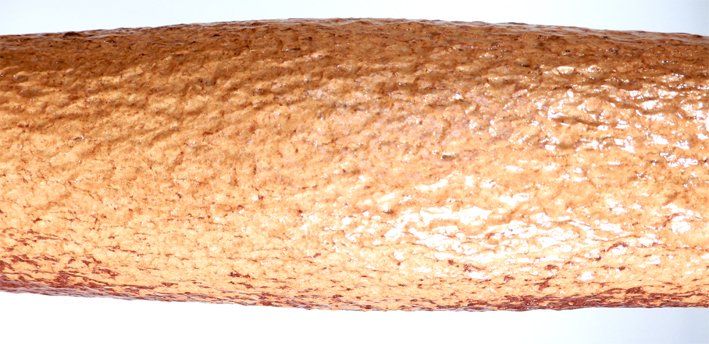
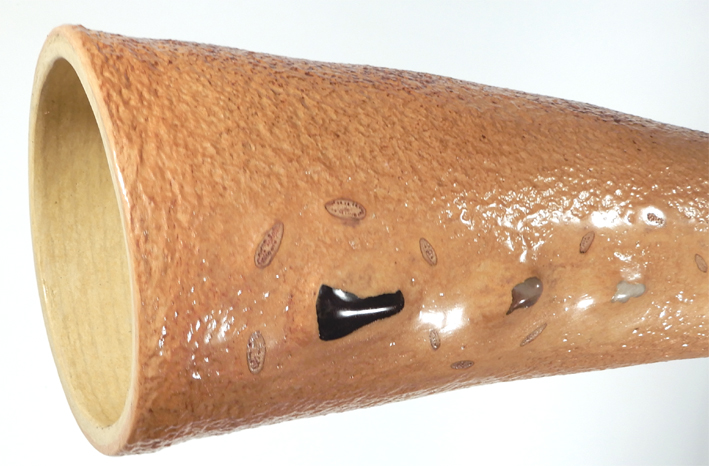
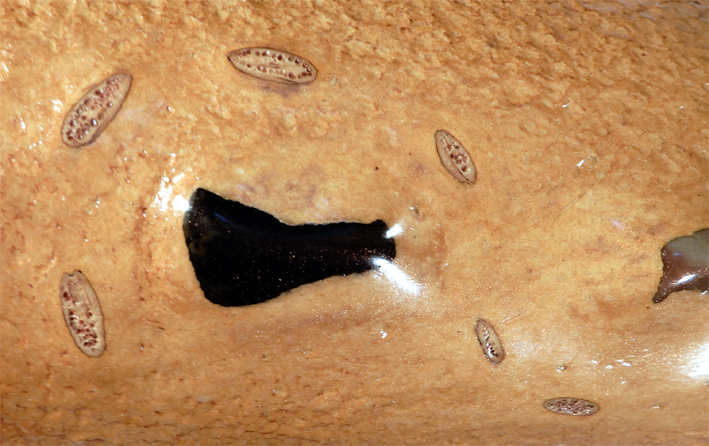
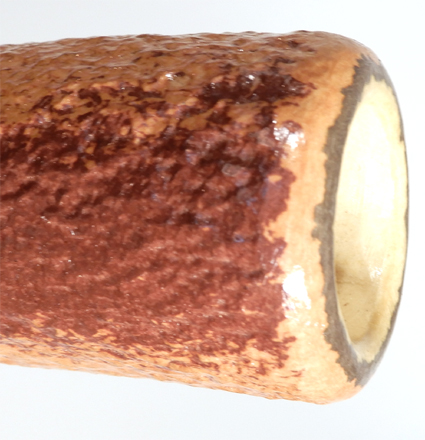 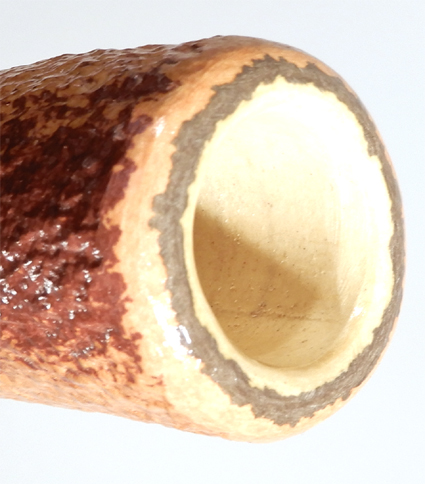
Dg494
Beschreibung des Didgeridoos:
You find the description in Englosh nbelow thre German text.
Das Didgeridoo Dg494 ist ein Instrument mit Grund Ton D2 und zylindrisch
komplexer Form, einem ersten Overblow etwa auf einem Ton über
der Oktave.
Mit 3,1 kg stellt es ein stabiles massives Didgeridoo dar, dessen
massive Wandstärke die tonalen Eigenschaften nicht viel beeinflusst.
Das Mundstck ist mit 31mm Innendurchmesser ein wenig breiter,
die Wandstärke am Mundstück mit 10 mm ist abgerundet
und bietet eine breite Kontaktfläche.
Das Didgeridoo hat durch die sehr breiten Zone am Bell einen starken,
lauten Basiston. Es hat eine akzeptabele Impedanz ( Resonanzwiderstand,
"Gegendruck"). Dg 494 ist ein Instrument dessen Eigenschaften
entstammen der Formennummer F443Z. Z steht für eine Zugentlastung
innerhalb der hängenden Form bei der Herstellung und verleiht
dem Instrument eine geschwungene gebogene Gestalt. An diesem Modell
ist das an dem leicht gebogen verlaufenden Bereich des Bell zu
erkennen.
Es handelt sich um eine der experimentellen Formen die sich
gut bewährt haben, das breite Mundstück und die zylindrische
Form erlauben es die Tonhöhen in weitem Bereich durch die
Lippenspannung zu verändern, zu "ziehen". Dg494
verlangt dadurch aber einen etwas höheren Einsatz von Luft,
so dass es eher geübte Didgeridoo SpielerInnen ansprechen
wird.
Die gebürstete Oberfläche des mit dunkel gelbem Ocker
gefärbten Instrumentes ist durch Sprüh- und Schrumpfungseffekte
des Hemstones strukturiert, "Rinde" wie wir das nenen.
Seitlich sind rotbraune Streifen aus dünklerem mit gebrannter
Siena gefärbtem Material aufgesprüht.
Am breiten Bell befinden sich Einlagen von drei verschieden
gefärbten Steinen aus dem Lafnitz Fluss, schlangenförmig
umrandet von angeschliffenen Olivenkernen. Am Mundstück sieht
man im Querschnitt den Aufbau aus drei verschiedenfarbigen Schichten
von Hempstone, innen hell gelb, eine graue Mittelschicht und die
ockerfarbene Deckschicht.
Die Verwendung verschieden gefärbter Schichten erlaubt
einen besseren Überblick über die Wandstärken bei
der Produktion.
Das Didgeridoo ist innen und aussen mit farblosem, monomerem,
überlackierbaren Zelluloselack gegen Feuchtigkeit geschützt.
Die genauen Tonverhältnisse wurden bei etwa Raumtemperatur
22-24 grdC am einige Minuten lang warm gespielten Instrument gemessen.
Ich gebe zu bedenken, dass die Angaben in Klammer Tonbereiche
kennzeichen, wobei die Anatomie und die eingesetzte Lippenspannung
der Menschen sehr individuell divergiert und dadurch Abweichungen
von den Testergebnissen festgestellt werden können.
Dieser Effekt zeigt sich stärker bei Didgeridoos mit
eher zylindrischer oder schmaler Mensur als bei stark konischen
Instrumenten mit weit offenem Bell. Die Temperatur der im Instrument
schwingenden Luftsäule hat einen sehr starken Einfluss auf
die Tonhöhen und wird von der Umgebungstemperatur aber auch
von der Intensität des Lufteinsatzes von Atem mit etwa Körpertemperatur
bestimmt. Dabei ändern 10 grd die Tonhöhe um etwa 30
Cent, je wärmer umso höher, bedingt durch die Änderung
der Schallgeschwindigkeit.
Zur Darstellung der Tonhöhen verwende ich die international
übliche englische Scheibweise: Grossbuchstabe mit Ziffer,
z.B.: A1 ist 55 Hz Die Angaben der Tonhöhen beziehen sich
meist auf den Kammerton A4= 440Hz. Für Instrumente die auf
Basis Kammerton A= 432 Hz konstruiert sind gebe ich die korrigierte
Skala zusätzlich an. Die Töne in Stimmlage auf Kammerton
A4 = 432 Hz liegen um etwa 32 Cent (exakt 31,7766 Cent) tiefer
als in Stimmlage mit Kammerton A4= 440Hz.
Angaben der Abweichungen von der exakten Tonhöhe des spontan
angespielten Instrumentes sind an der Note und die durch Veränderung
der Lippenspannung gemessenen Bereiche sind daneben in Klammer
in Cent angegeben, ein Halbton wird geteilt in 100 Cent, eine
Oktave wird geteilt in 1200 Cent. Der Grundton und die Overblows
sind durch Schrägstriche getrennt.
Töne fr A=440: D2-10 (Db2 bis D+30) // E3+30 (E3-10 bis
E3+50) / A3+30 (A3-10 bis A3+50) / F4-30 / A4-40
Dg494
Description of the didgeridoo The didgeridoo:
Dg494 is an instrument with fundamental D2 and cylindrically complex
shape, with first overblow approximately on a note above the octave.
With 3,1 kg it represents a stable solid didgeridoo, whose solid
wall thickness does not affect the tonal characteristics much.
The mouthpiece is a little bit wider with 31mm inner diameter,
the wall thickness at the mouthpiece with 10mm is rounded off
and offers a wide contact area.
The didgeridoo has a strong, loud base tone due to the very
wide zone on the bell. It has acceptable impedance, resonance
resistance, "back pressure".
Dg 494 is an instrument whose characteristics come from the mold
number F443Z. Z stands for a strain relief inside the hanging
mold during manufacturing and gives the instrument a curved bent
shape. On this model, this can be seen in the slightly curved
area of the Bell.
This is one of the experimental shapes that have worked well,
the wide mouthpiece and cylindrical shape allow the pitches to
be altered over a wide range by lip tension, to "pull". Dg494
requires a slightly higher use of air as a result, however, so
it will appeal more to experienced didgeridoo players.
The brushed surface of the instrument, colored with dark yellow
ocher, is textured by spraying and shrinking effects of the Hemstone,
"bark" as we call it. Reddish-brown stripes of thinner material
dyed with burnt sienna are sprayed on the sides.
On the wide bell there are inlays of three differently colored
stones from the Lafnitz River, serpentine bordered by polished
olive pits. On the mouthpiece you can see in cross-section the
structure of three different colored layers of Hempstone, light
yellow inside, a gray middle layer and the ocher top layer.
The use of differently colored layers allows a better overview
of the wall thicknesses during production. The didgeridoo is protected
against moisture inside and out with colorless, monomeric, paintable
cellulose lacquer.
The exact tone ratios were measured at about room temperature
22-24 grdC on the instrument played warm for a few minutes. I
would like to point out that the data in parentheses indicate
ranges of tone, whereas the anatomy and the applied lip tension
of of the people diverges very individually and therefore deviations
from the test results can be found.
This effect is more apparent in didgeridoos with a more cylindrical
or narrow bore than in highly conical instruments with a wide
open bell.
The temperature of the air column vibrating in the instrument
has a very strong influence on the pitches and is determined by
the ambient temperature but also by the intensity of the air input
from breath at about body temperature. Here 10 grd change the
pitch by about 30 cents, the warmer the higher, due to the change
in the speed of sound.
For the representation of the pitches I use the internationally
usual English notation: Capital letter with digit, e.g.: A1 is
55 Hz The indications of the pitches mostly refer to the concert
pitch A4= 440Hz. For instruments constructed on the basis of concert
pitch A= 432 Hz, I additionally indicate the corrected scale.
The notes in tuning on concert pitch A4 = 432 Hz are about 32
cents (exactly 31.7766 cents) lower than in tuning on concert
pitch A4= 440Hz.
Indications of deviations from the exact pitch of the spontaneously
played instrument are given on the note and the ranges measured
by changing the lip tension are indicated next to it in parentheses
in cents, a semitone is divided into 100 cents, an octave is divided
into 1200 cents. The fundamental and the overblows are separated
by slashes.
Keys for A=440: D2-10 (Db2 to D+30) // E3+30 (E3-10
to E3+50) / A3+30 (A3-10 to A3+50) / F4-30 / A4-40
Dg494 Sound
sample 01
|
